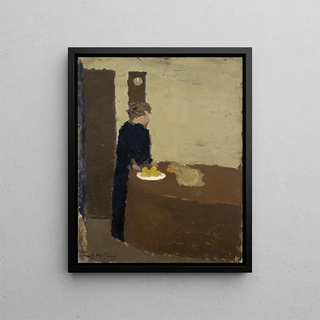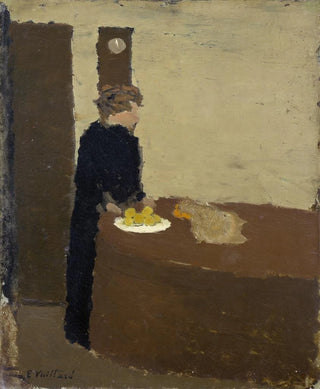Art print | Woman in Black - Édouard Vuillard


View from behind

Frame (optional)
Édouard Vuillard's "Femme en noir" is a masterpiece that embodies the very essence of intimate life and the subdued atmospheres of the late 19th century. Through this canvas, the artist invites us to delve into a universe where intimacy and melancholy intersect. The female silhouette, draped in dark shades, appears to blend into a setting that evokes the warmth of a home, while also revealing a certain emotional distance. This artwork, both simple and complex, captures the eye and sparks curiosity, as if each brushstroke reveals a hidden story, a latent emotion.
Style and uniqueness of the artwork
Vuillard's style is characterized by an intimate approach and a subtle use of colors. In "Femme en noir," he skillfully plays with shadows and light to create an atmosphere that is both mysterious and warm. The composition is carefully orchestrated, with each element of the painting contributing to the overall harmony. The woman, although central, is not isolated; she is part of an environment familiar to her, which enhances the sense of intimacy. The decorative motifs, typical of the Nabi movement to which he belongs, add an extra dimension to the piece, transforming the painting into a true scene of life. This blend of realism and abstraction gives the work a depth that invites contemplation.
The artist and his influence
Édouard Vuillard, a prominent member of the Nabis group, distinguished himself by his ability to capture everyday life with a unique sensitivity. His work is deeply rooted in the social and artistic context of his time, marked by a search for new forms of expression. Vuillard was influenced by the Impressionists, but he quickly developed a style that was his own, favoring interior scenes and intimate portraits. His innovative approach paved the way for many artists who sought to explore the nuances of domestic life and human emotions. By emphasizing intimacy and the psychology of characters, Vuillard helped redefine genre painting, giving it a more profound and personal dimension.

Matte finish

View from behind

Frame (optional)
Édouard Vuillard's "Femme en noir" is a masterpiece that embodies the very essence of intimate life and the subdued atmospheres of the late 19th century. Through this canvas, the artist invites us to delve into a universe where intimacy and melancholy intersect. The female silhouette, draped in dark shades, appears to blend into a setting that evokes the warmth of a home, while also revealing a certain emotional distance. This artwork, both simple and complex, captures the eye and sparks curiosity, as if each brushstroke reveals a hidden story, a latent emotion.
Style and uniqueness of the artwork
Vuillard's style is characterized by an intimate approach and a subtle use of colors. In "Femme en noir," he skillfully plays with shadows and light to create an atmosphere that is both mysterious and warm. The composition is carefully orchestrated, with each element of the painting contributing to the overall harmony. The woman, although central, is not isolated; she is part of an environment familiar to her, which enhances the sense of intimacy. The decorative motifs, typical of the Nabi movement to which he belongs, add an extra dimension to the piece, transforming the painting into a true scene of life. This blend of realism and abstraction gives the work a depth that invites contemplation.
The artist and his influence
Édouard Vuillard, a prominent member of the Nabis group, distinguished himself by his ability to capture everyday life with a unique sensitivity. His work is deeply rooted in the social and artistic context of his time, marked by a search for new forms of expression. Vuillard was influenced by the Impressionists, but he quickly developed a style that was his own, favoring interior scenes and intimate portraits. His innovative approach paved the way for many artists who sought to explore the nuances of domestic life and human emotions. By emphasizing intimacy and the psychology of characters, Vuillard helped redefine genre painting, giving it a more profound and personal dimension.






